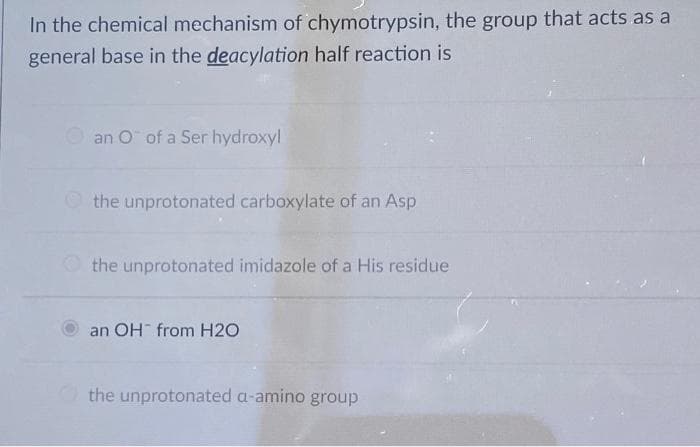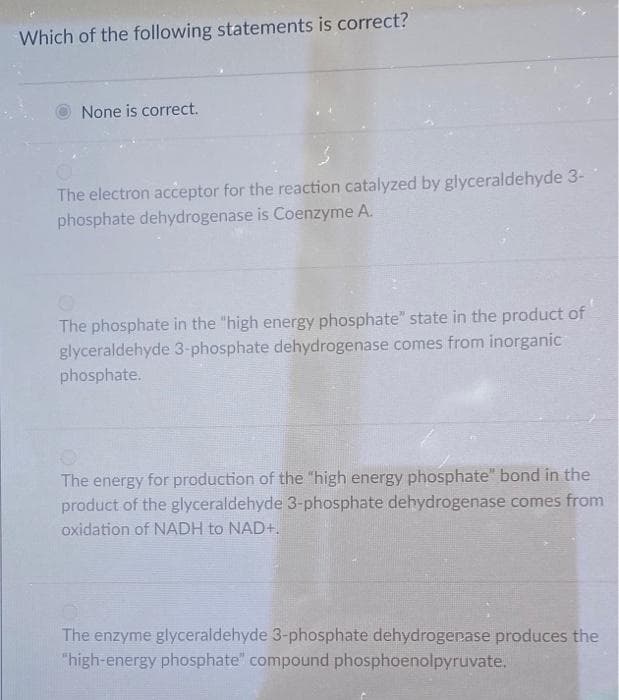In the chemical mechanism of chymotrypsin, the group that acts as a general base in the deacylation half reaction is O an O of a Ser hydroxyl the unprotonated carboxylate of an Asp the unprotonated imidazole of a His residue an OH from H2O the unprotonated a-amino group
In the chemical mechanism of chymotrypsin, the group that acts as a general base in the deacylation half reaction is O an O of a Ser hydroxyl the unprotonated carboxylate of an Asp the unprotonated imidazole of a His residue an OH from H2O the unprotonated a-amino group
Biochemistry
6th Edition
ISBN:9781305577206
Author:Reginald H. Garrett, Charles M. Grisham
Publisher:Reginald H. Garrett, Charles M. Grisham
Chapter25: Nitrogen Acquisition And Amino Acid Metabolism
Section: Chapter Questions
Problem 19P
Related questions
Question
Please answer both and explain why. I'll rate fast thank you

Transcribed Image Text:In the chemical mechanism of chymotrypsin, the group that acts as a
general base in the deacylation half reaction is
an O of a Ser hydroxyl
O the unprotonated carboxylate of an Asp
the unprotonated imidazole of a His residue
an OH from H2O
the unprotonated a-amino group

Transcribed Image Text:Which of the following statements is correct?
None is correct.
The electron acceptor for the reaction catalyzed by glyceraldehyde 3-
phosphate dehydrogenase is Coenzyme A.
The phosphate in the "high energy phosphate" state in the product of
glyceraldehyde 3-phosphate dehydrogenase comes from inorganic
phosphate.
The energy for production of the "high energy phosphate" bond in the
product of the glyceraldehyde 3-phosphate dehydrogenase comes from
oxidation of NADH to NAD+.
The enzyme glyceraldehyde 3-phosphate dehydrogenase produces the
"high-energy phosphate" compound phosphoenolpyruvate.
Expert Solution
This question has been solved!
Explore an expertly crafted, step-by-step solution for a thorough understanding of key concepts.
This is a popular solution!
Trending now
This is a popular solution!
Step by step
Solved in 2 steps

Recommended textbooks for you

Biochemistry
Biochemistry
ISBN:
9781305577206
Author:
Reginald H. Garrett, Charles M. Grisham
Publisher:
Cengage Learning

Human Heredity: Principles and Issues (MindTap Co…
Biology
ISBN:
9781305251052
Author:
Michael Cummings
Publisher:
Cengage Learning

Biochemistry
Biochemistry
ISBN:
9781305577206
Author:
Reginald H. Garrett, Charles M. Grisham
Publisher:
Cengage Learning

Human Heredity: Principles and Issues (MindTap Co…
Biology
ISBN:
9781305251052
Author:
Michael Cummings
Publisher:
Cengage Learning